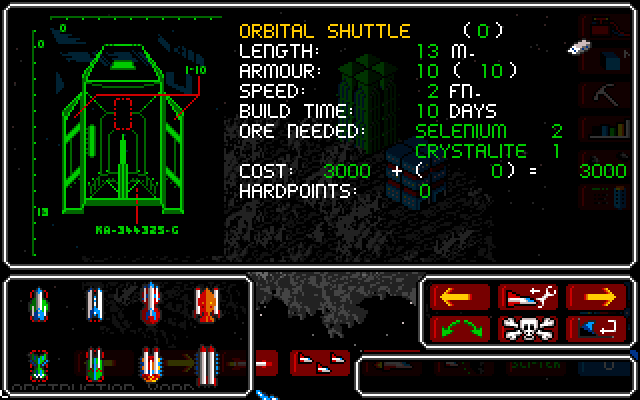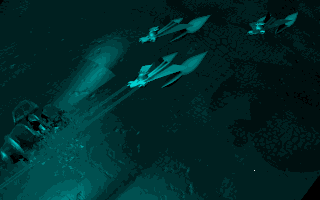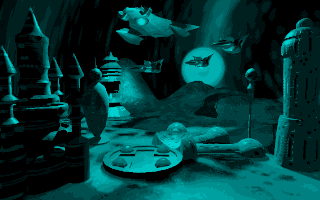This page summarizes features that were removed from the game at one point or another.
Orbital Shuttle

A ship known as the Orbital Shuttle appears in the game data. The ship has sprites, names, and game statistics, but it has no wireframe graphic for the shipbuilding screen.
It is referred to by text string #126, which is the first of eight consecutive strings of ship names. (Orbital Space Dock appears much later at string #173, suggesting that was added later.) Despite not appearing in the game, its name is translated.
- English: ORBITAL SHUTTLE
- French: VAISSEAU ORBITAL
- German: ORB.-TRANSPORTER
The Orbital Shuttle has an internal ID number of 1 (one before the Assault
Fighter, at 2). It has following statistics:
- Armour: 10
- Speed: 2 FN. (equal to Scoutship)
- Hardpoints: 0
- Build time: 10 days
- Ore: 2 Selenium, 1 Crystalite
- Cost: 3,000 CD (equal to Scout Ship)
- Length: 13 m (equal to Assault Fighter)
Here’s what it would look like if you could build it (ignore the Assault Fighter wireframe being used as a stand-in):

It’s a mystery what it was used for, since it has no weapons. Perhaps the originally intended purpose was to transport population or ground troops. Alien ship classes tend to mirror this layout of four small ships, two medium and two large.
Enemy ship detection
The CU Amiga demo notifies the player if an
enemy ship enters sensor range. The final release of the game doesn’t do this.
However, there’s still a sound file called k240_3:speech/ENEMYVES.MGL for this
event, which says “Enemy vessel detected”.
The bjork sound test cheat code has two
entries for the next voice clip in the list, EQUIPMAL.MGL (“Equipment
malfunction”), which suggests that previously appeared in the sound test, but
was removed.
There’s a likely reason why this alert was removed. When the enemy launches an attack with ships, it is always in the form of a fleet, allowing the player the chance to intercept it. Lone ships are only ever deployed in two circumstances: Scoutships, and Transporters. These will never approach your colony deliberately (although they may accidentally do so, such as if you and the alien both send a Transporter to colonise the same asteroid and yours gets their first).
The alert was mostly useless, since individual alien ships are never actually approaching you, only passing through your sensor range. There’s also nothing you can do about it, since you can’t intercept individual ships that aren’t part of a fleet, so it’s frustrating.
Alternate win screen
| Standard win screen | Unused win screen |
|---|---|
 |
 |
As mentioned in extracted images, an alternate win screen
graphic appears on disk in the file k240_3:outro3.mgl. It appears likely that
it was intended to be used when the player defeats the Swixarans.
The game code has three strings containing the filenames of game over screens.
The first is k240_3:outro1.mgl, used upon defeating any alien but Swixaran.
The second is k240_3:outro2.mgl, used when the player is defeated. The third
is used when the player defeats the Swixarans, but it it set to the default win
screen, k240_3:outro1.mgl.
It seems likely that outro3 was intended to be used in the third slot, but was unused for whatever reason. There are two leading theories to explain this:
- The 3D render may not have been completed on time. Based on a screenshot of
the standard win screen in The One Amiga #68 (May 1994) in its
K240 review, the review
copies of K240 distributed in March 1994 used
k240_3:satpic.mglas a stand-in for the win screen graphic. This suggests that the 3D rendered win screens were not completed until very late in development. It’s plausible that outro3 was temporarily replaced with outro1, and while outro3 was completed on time for inclusion on disk, it was not completed on time to actually produce a new build of the game executable, which may have required additional testing. - Outro3 may have caused issues due to its large filesize. Analysis of game
code suggests that the buffer used by the MGL decompression routine is 28,064
bytes. This is enough to hold the next-largest file,
outro2.mgl(27,215 bytes compressed), butoutro3.mglis 31,118 bytes compressed, probably due to the amount of detail making it harder to compress well. It could therefore in theory overrun the buffer, which would have unpredictable results.
Hex editing the game to change the second outro1 to outro3 works correctly.
Missing alien ships and buildings
There are certain alien buildings and ships in the game code which they will never actually build. The four hardest aliens all have their third small ship class dummied out, and the easiest alien has a missing building.
- Kll-Kp-Qua Science Hive
 The game code says that this operates the same as the Data Hive, which helps to
spot spy satellites. However, none of the building clusters include it, so it
will never be built. One of the clusters attempts to build a non-existent
building in the Anti-Missile Pod slot, so it may be that the Science Hive was
meant to take that slot, although it could also be that Anti-Missile Pods were
removed to make the first alien easier.
The game code says that this operates the same as the Data Hive, which helps to
spot spy satellites. However, none of the building clusters include it, so it
will never be built. One of the clusters attempts to build a non-existent
building in the Anti-Missile Pod slot, so it may be that the Science Hive was
meant to take that slot, although it could also be that Anti-Missile Pods were
removed to make the first alien easier.- Ax’Zilanth ship #3
 A small ship with 2 FN speed and 40 Armour. The ship’s stats say it only has
two hardpoints, but it has four listed: Photon Cannon, Laser, Ion Cannon, and
Napalm Orb.
A small ship with 2 FN speed and 40 Armour. The ship’s stats say it only has
two hardpoints, but it has four listed: Photon Cannon, Laser, Ion Cannon, and
Napalm Orb.- Tylaran ship #3
 A small ship with 2 FN speed and 40 Armour. It has four hardpoints: Photon
Cannon, Laser, Ion Cannon, and Napalm Orb.
A small ship with 2 FN speed and 40 Armour. It has four hardpoints: Photon
Cannon, Laser, Ion Cannon, and Napalm Orb.- Rigellian ship #3
 A small ship with 2 FN speed and 40 Armour. Has four hardpoints: Photon Cannon,
Laser, Ion Cannon, and Napalm Orb. The Photon Cannon deals 0 damage because the
Rigellians do not have Photon technology.
A small ship with 2 FN speed and 40 Armour. Has four hardpoints: Photon Cannon,
Laser, Ion Cannon, and Napalm Orb. The Photon Cannon deals 0 damage because the
Rigellians do not have Photon technology.- Swixaran ship #3
 A small ship with 2 FN speed and 40 Armour. It has 4 hardpoints: Photon Cannon,
Laser, Ion Cannon, and Napalm Orb. The Laser Cannon deals 0 damage because the
Swixarans do not use Laser technology. The Swixarans also do not normally use
Napalm or any other fire-based weapons.
A small ship with 2 FN speed and 40 Armour. It has 4 hardpoints: Photon Cannon,
Laser, Ion Cannon, and Napalm Orb. The Laser Cannon deals 0 damage because the
Swixarans do not use Laser technology. The Swixarans also do not normally use
Napalm or any other fire-based weapons.
It’s worth noting that for the two species that do use ship #3, they both have oddities. The Kll-Kp-Qua’s has 80 Armour and zero hardpoints, while the Ore Eaters’ is listed as having two hardpoints, but it has four hardpoints listed in the stats. Perhaps a design change was made at some point to nerf these small heavy ships.
Planned features
According to an interview with the game’s programmer Graeme Ing in The One Amiga #59 (Aug 1993), various planned features were cut from the game for technical reasons and time limits.
- Targeting individual buildings
- It was initially intended that you could target individual buildings. (Amiga Action #28 (Jan 1992)) Dune II (1992) would establish this as as a standard feature of what would would thereafter known as the real-time strategy genre. In K240, you can only target specific asteroids with missiles or ships, but after that the targeting is random.
- Multiplayer
- Populous (1989) featured null-modem multiplayer. For K240, however, the amount of data necessary to transfer made this impractical. (The One Aug 1993)
- Scenario goals
- Originally, alien scenarios would have mission goals, which may be optional. Examples given included destroying a shield generator, finding a certain resource before the enemy does, (The One Aug 1993) disabling convoys, and locating bases. (Amiga Action Sept 1993) In the final game, only the Swixarans have a mission goal, to destroy asteroid cloak generators.
- Research
- According to Amiga Power #30 (Oct 1993), K240 would allow the player to acquire technology by scientific research. The final game would have players buying technology blueprints from Sci-Tek instead. Sci-Tek was already part of the game design by the time of the CU Amiga Mar 1994 interview.
« Back to index page